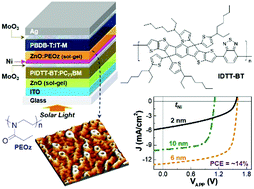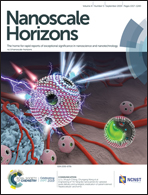High efficiency tandem polymer solar cells with MoO3/Ni/ZnO:PEOz hybrid interconnection layers†
Abstract
Here we report high efficiency tandem polymer solar cells with hybrid electron-collecting buffer layers (ECBLs) for interconnection between front and rear cells. The hybrid ECBLs, poly(2-ethyl-2-oxazoline) (PEOz)-embedded ZnO (ZnO:PEOz), were prepared via low-temperature sol–gel processes on nickel (Ni) interlayers that are desposited on molybdenum oxide (MoO3) buffer layers. The Ni interlayers were employed to act as an electrical conductor and a protection layer for the MoO3 layers against the attack of solvent during spin-coating of the ZnO:PEOz layers. A new conjugated polymer was synthesized and mixed with soluble fullerenes to make polymer:fullerene bulk heterojunction (BHJ) layers for the front cells, while polymer:nonfullerene BHJ layers were employed for the rear cells. The thickness of the Ni interlayers was varied up to 10 nm in order to investigate the trade-off between optical transmittance and electrical conductivity in the tandem cells. The results showed that the ZnO:PEOz ECBLs delivered a nanocratered surface in the tandem polymer solar cells and the device performaces were greatly affected by the Ni thickness. The optimized tandem polymer solar cells exhibited a power conversion efficiency of 14.22% at the Ni thickness of 6 nm.



 Please wait while we load your content...
Please wait while we load your content...